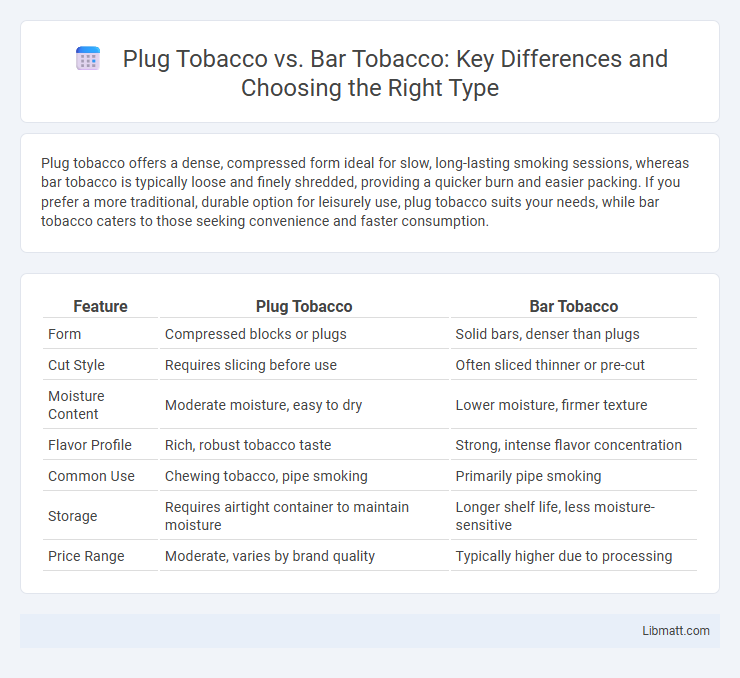Plug tobacco offers a dense, compressed form ideal for slow, long-lasting smoking sessions, whereas bar tobacco is typically loose and finely shredded, providing a quicker burn and easier packing. If you prefer a more traditional, durable option for leisurely use, plug tobacco suits your needs, while bar tobacco caters to those seeking convenience and faster consumption.
Table of Comparison
| Feature | Plug Tobacco | Bar Tobacco |
|---|---|---|
| Form | Compressed blocks or plugs | Solid bars, denser than plugs |
| Cut Style | Requires slicing before use | Often sliced thinner or pre-cut |
| Moisture Content | Moderate moisture, easy to dry | Lower moisture, firmer texture |
| Flavor Profile | Rich, robust tobacco taste | Strong, intense flavor concentration |
| Common Use | Chewing tobacco, pipe smoking | Primarily pipe smoking |
| Storage | Requires airtight container to maintain moisture | Longer shelf life, less moisture-sensitive |
| Price Range | Moderate, varies by brand quality | Typically higher due to processing |
Introduction to Plug Tobacco and Bar Tobacco
Plug tobacco consists of compressed blocks of tobacco leaves, designed for slicing into smaller portions for chewing or smoking, maintaining a slow-burning, flavorful experience. Bar tobacco refers to loose tobacco cut into strips or flakes, commonly used for rolling cigarettes or pipe smoking, offering greater flexibility in preparation and flavor customization. Both forms cater to different smoker preferences, with plug tobacco emphasizing compactness and longevity, while bar tobacco prioritizes ease of use and blending potential.
What is Plug Tobacco?
Plug tobacco is a dense, compressed form of chewing tobacco made by pressing shredded tobacco leaves into a solid block. It offers a slower, longer-lasting chew compared to loose or bar tobacco, providing a rich and robust flavor ideal for users seeking a traditional, satisfying tobacco experience. Your choice between plug and bar tobacco depends on preferred texture and nicotine intensity, with plug tobacco delivering a more concentrated and enduring chew.
What is Bar Tobacco?
Bar tobacco is a type of moist, pressed tobacco often sold in block or plug form, making it dense and compact compared to loose tobacco varieties. This form is typically used by smokers who prefer to slice or break off pieces to roll their own cigarettes or for pipe smoking. You can easily control the amount and moisture with bar tobacco, offering a customized smoking experience.
Key Differences Between Plug and Bar Tobacco
Plug tobacco is compressed into dense, solid blocks requiring slicing, offering slow-burning and robust smoking experiences, while bar tobacco consists of shredded or loosely packed leaves designed for easy rolling and quicker lighting. Plug tobacco generally has higher moisture content and longer curing times, resulting in richer flavors and stronger nicotine delivery compared to the lighter, drier bar tobacco. Storage and handling differ as plug tobacco demands careful slicing and moisture maintenance, whereas bar tobacco is more user-friendly but less durable.
Flavor and Texture Comparisons
Plug tobacco delivers a rich, robust flavor with a dense and moist texture, making it ideal for slow, long-lasting smoking experiences. Bar tobacco, often pressed into thinner sheets or bars, offers a smoother, milder flavor profile and a slightly drier texture that allows for easier cutting and packing. The distinct preparation methods of plug and bar tobaccos directly influence their flavor intensity and mouthfeel, catering to different preferences among pipe and roll-your-own tobacco users.
Preparation and Usage Methods
Plug tobacco requires cutting or slicing into smaller pieces before use, often placed in the mouth for chewing or used in pipes. Bar tobacco, typically shredded and loose, is ready to be packed into rolling papers, pipes, or cigarettes without further preparation. Understanding these distinct preparation and usage methods can enhance your tobacco experience based on personal preference.
Popular Brands and Varieties
Plug tobacco, known for its compressed blocks, is commonly offered by brands like Beechnut, Stoker's, and Carter Hall, delivering rich and moist blends ideal for slow burning. Bar tobacco, characterized by its sliced, ribbon-cut form, is favored by brands such as Captain Black, Prince Albert, and Lane, known for smooth, aromatic varieties perfect for pipe smoking. Your choice between these popular brands depends on preference for tobacco texture and flavor intensity.
Pros and Cons of Plug Tobacco
Plug tobacco offers a concentrated form of chewing tobacco that is easier to portion and store, with its compressed blocks reducing moisture loss. However, it can be tougher to chew and may require more effort to break apart compared to loose bar tobacco, which is looser and often more flavorful but messier to handle. Your choice depends on convenience and personal preference for texture and nicotine intensity.
Pros and Cons of Bar Tobacco
Bar tobacco offers a versatile selection of rich, moist blends favored for easy packing and reliable burn, making it ideal for hand-rolled cigarettes and pipes. However, its higher moisture content can lead to slower drying times and inconsistent burn rates, which may frustrate users seeking quick preparation. Compared to plug tobacco, bar tobacco generally provides a smoother, milder flavor but less compact storage efficiency.
Which One Should You Choose?
Choosing between plug tobacco and bar tobacco depends on your smoking preferences and preparation time; plug tobacco is a compressed, dense form that requires slicing before use, offering a longer-lasting experience with a slower burn. Bar tobacco is easier to use, as it is already shredded or in loose leaf form, providing convenience and faster ignition suitable for those who prefer quick preparation. Consider your desired smoking duration and ease of use when deciding, with plug tobacco favored by traditionalists and bar tobacco appealing to casual or on-the-go smokers.
Plug tobacco vs Bar tobacco Infographic

 libmatt.com
libmatt.com